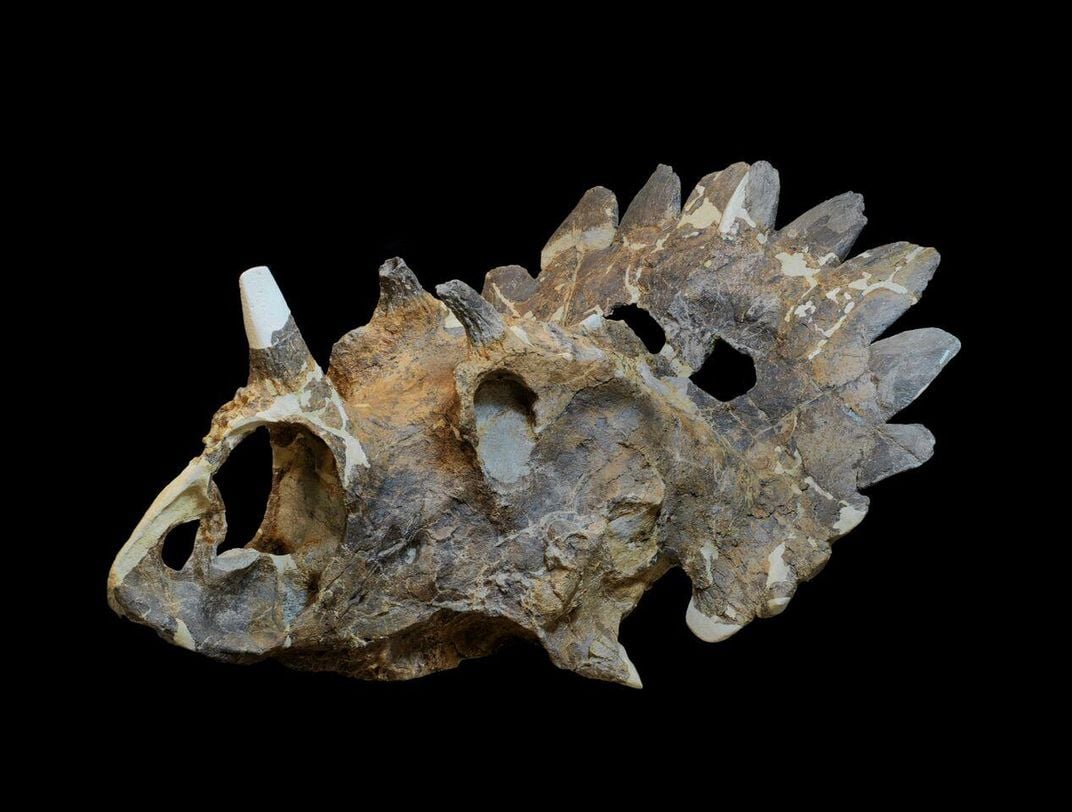The ‘Hellboy’ Dinosaur, a New Cousin of Triceratops, Is Fossil Royalty
The horned dinosaur wears a built-in crown and offers evidence of many more undiscovered species in North America
:focal(761x420:762x421)/https://tf-cmsv2-smithsonianmag-media.s3.amazonaws.com/filer/52/6c/526c72be-21de-4a4c-9b4d-ac1851a0b707/92668.jpg)
“Heavy is the head that wears the crown.” That's especially true in the case of Regaliceratops peterhewsi: The skull of this recently discovered dinosaur with crown-like headgear tops the scales at 592 pounds.
The new species, a cousin of the Triceratops, was formally named for its regal appearance—the skull bears a bony frill decorated with a series of pentagon-shaped plates, like spikes on a crown. Compared to Triceratops, the dinosaur also possesses a taller nose horn and two “comically small” horns over its eyes. As such, the researchers have nicknamed the creature Hellboy. No matter what you call it, though, the 70-million-year-old fossil represents an unexpected case of evolutionary convergence among horned dinosaurs, and it hints at the potential for more fossil wonders waiting to be unearthed.
“This discovery shows that we are perhaps still quite a ways from knowing the complete diversity of dinosaur species in the Late Cretaceous of western North America,” says James Farlow, a professor of geology at Indiana University-Purdue University Fort Wayne. "The evolutionary tree presented by the authors suggests that an immediate ancestor of Regaliceratops that would have lived a few million years ago has yet to be found. So there are plenty of interesting dinosaurs still to be discovered."
Geologist Peter Hews found the fossil skull a decade ago along the Oldman River in southeastern Alberta, Canada, a place where horned dinosaurs have rarely been unearthed. Paleontologists Caleb M. Brown and Donald Henderson at the Royal Tyrrell Museum had the opportunity to examine the skull after it had been excavated and cleaned. As they report today in Current Biology, several bizarre features of the dinosaur’s skull quickly set it apart from its close relatives.
There are two historical classifications of horned dinosaurs: Chasmosaurines and Centrosaurines. Species belonging to the Chasmosaurines, like Triceratops, have a small horn over the nose, large horns over the eyes and a large frill. Centrosaurines, on the other hand, have a large horn over the nose, small ones over the eyes and a small frill.
The Regaliceratops contains traits of both, so Brown and Henderson have concluded that the species provides evidence of evolutionary convergence—the dinosaur evolved from one lineage but then independently developed traits from another. Its relatively young age suggests that Regaliceratops existed after Centrosaurines were believed to be extinct, indicating that their characteristics were later integrated into other species, many of which may not have been excavated yet.
“This find tells us more about the kinds of horned dinosaurs that lived just before Triceratops was on the scene,” says Andrew Farke, curator at the Raymond M. Alf Museum of Paleontology. “I am now really curious to see what other oddities might have been around at the same time—this new beast is an important data point.”

For instance, the emergence of Regaliceratops shows that many different combinations and types of horns and frills could have existed beyond what is already known. “Up until now, all Chasmosaurines from the Maastrichtian"—the latest stage of the Cretaceous—"had very similar body plans,” says Brown. “This new species was completely unexpected and shows that the horns and frills were much more variable than previously thought.”
Today, paleontologists continue to investigate and debate the role of the frills in dinosaurs like the Regaliceratops. “When horned dinosaurs were first found it was suggested that the horns and frill were used for defense,” says Brown. “We have all seen illustrations of Triceratops doing battle with Tyrannosaurus.” However, research has increasingly shown that the horns and frills more likely served as useful ornamentation indicating heath and sexual prowess. “The frills of horned dinosaurs are highly variable in shape, and most scientists consider it likely that these structures were used for display,” says Hans-Dieter Sues, curator of vertebrate paleontology at the Smithsonian National Museum of Natural History.
“The best supported idea at the moment is that these structures functioned much like billboards—similar to horns and antlers in mammals today,” adds Brown.
Finding more horned dinosaurs in North America could help paleontologists sort through the competing theories, and Brown notes that the hunt is on for the other undiscovered species that could remain at large.
/https://tf-cmsv2-smithsonianmag-media.s3.amazonaws.com/accounts/headshot/profile.jpg)
/https://tf-cmsv2-smithsonianmag-media.s3.amazonaws.com/accounts/headshot/profile.jpg)